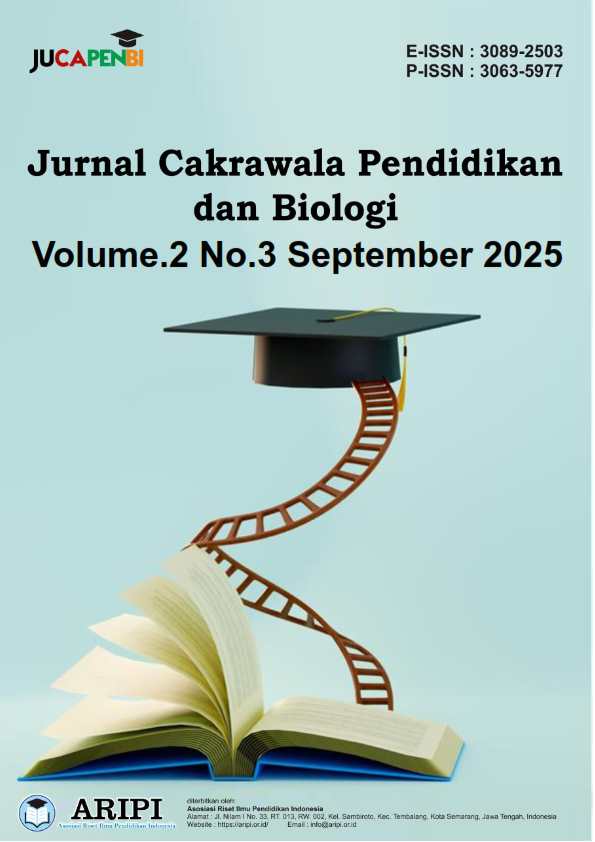Identifikasi dan Karakterisasi Bakteri Asam Laktat dari Bekasam Ikan Gabus (Channa striata) Berdasarkan Pewarnaan Gram dan Morfologi Koloni
DOI:
https://doi.org/10.61132/jucapenbi.v2i3.580Keywords:
Bekasam, Snakehead Fish, Lactic Acid Bacteria, Gram Staining.Abstract
Bekasam is a traditional Indonesian fermented food produced through spontaneous fermentation involving microorganisms, particularly lactic acid bacteria (LAB). LAB plays a crucial role in the fermentation process by producing lactic acid, which lowers pH, inhibits pathogenic microbial growth, and enhances flavor and food safety. This study aimed to identify and characterize LAB isolated from fermented snakehead fish (Channa striata) based on Gram staining and colony morphology. The research began with bacterial isolation using NA Nutrient Agar, followed by macroscopic observation of colony characteristics including shape, edge, elevation, color, and size. Subsequently, Gram staining was performed to determine the cell wall structure and microscopic morphology of the bacteria. The results showed that the bacterial isolates from bekasam generally had circular colonies, white to cream in color, smooth surface, and were Gram-positive rod-shaped cells. In conclusion, bekasam from snakehead fish contains dominant lactic acid bacteria with distinctive colony morphology and Gram-positive characteristics, indicating potential as a natural starter culture for food fermentation.
References
Andayani, R., Sari, R. N., & Fitriana, R. (2020). Isolation and characterization of lactic acid bacteria from fermented fish (bekasam). Jurnal Teknologi dan Industri Pangan, 31(2), 123–129.
Candra, J. I., Zahiruddin, W., & Desniar. (2010). Isolation and characterization of lactic acid bacteria from bandeng (Chanos chanos) bekasam. Jurnal Pengolahan Hasil Perikanan Indonesia, 10(2).
Desniar, R., Rusmana, I., Suwanto, A., & Mubarik, N. R. (2013). Characterization of lactic acid bacteria isolated from an Indonesian fermented fish (bekasam) and their antimicrobial activity against pathogenic bacteria. Emirates Journal of Food and Agriculture, 25(6).
Ga, O., & Ome, A. (2017). Pengaruh media fermentasi dan konsentrasi garam terhadap kualitas bekasam ikan gabus (Channa striata) [Skripsi, Universitas Muhammadiyah Sidoarjo].
Hwanhlem, N., Buradaleng, S., Wattanachant, S., Benjakul, S., & Tani, A. (2011). Isolation and screening of lactic acid bacteria from Thai traditional fermented fish (Pla-ra) with high proteolytic activity. ScienceAsia, 37(5), 335–342.
Melizah, A., Husin, S., & Alkaf, S. (2018). Identification of lactic acid bacteria isolate from fermentation food bekasam. Bioscientia Medicina: Journal of Biomedicine and Translational Research, 2(1), 16–23.
Mumtianah, O. N., Kusdiyantini, E., & Budiharjo, A. (2014). Isolasi, karakterisasi bakteri asam laktat, dan analisis proksimat dari bekasam ikan mujair (Oreochromis mossambicus). Jurnal Akademika Biologi, 3(2).
Novianti, D. (2016). Kuantitasi dan identifikasi bakteri asam laktat serta konsentrasi asam laktat dari fermentasi ikan gabus, nila, dan sepat pada pembuatan bekasam. Sainmatika, 10(2), 1–8.
Prasetyo, R. H., Yunianta, N., & Adi, D. S. (2020). Uji potensi antibakteri bakteri asam laktat dari bekasam terhadap bakteri patogen. Jurnal Pangan dan Agroindustri, 8(4), 135–142.
Puspitasari, D., Nurjanah, S., & Andarwulan, N. (2021). Karakterisasi fenotipik dan genetik bakteri asam laktat dari produk fermentasi ikan tradisional. Jurnal Bioteknologi & Biosains Indonesia, 8(2), 137–144.
Rahman, M. A., Sultana, M., & Sarker, N. R. (2021). Identification of probiotic lactic acid bacteria from traditional fermented fish and their functional characteristics. Journal of Advanced Veterinary and Animal Research, 8(1), 20–27.
Rani, R. P., Anandharaj, M., & Rani, R. P. (2020). Functional properties of lactic acid bacteria isolated from fermented fish products: An overview. Food Control, 118, 107–115.
Rhee, M. S., Lee, S. Y., Dougherty, R. H., & Kang, D. H. (2011). Antimicrobial effects of mustard flour and acetic acid against E. coli O157:H7, Listeria monocytogenes, and Salmonella enterica. International Journal of Food Microbiology, 142(1–2), 133–138.
Surono, I. S. (2015). Fermented foods and beverages in Southeast Asia. In R. R. Watson & V. R. Preedy (Eds.), Probiotics, prebiotics, and synbiotics (pp. 301–312). Academic Press.
Tamang, J. P., Watanabe, K., & Holzapfel, W. H. (2016). Review: Diversity of microorganisms in global fermented foods and beverages. Frontiers in Microbiology, 7, 377.
Widodo, E., Santoso, D., & Rahmawati, L. (2023). Perubahan kimiawi dan mikrobiologis selama fermentasi bekasam ikan nila menggunakan starter tunggal dan campuran. Jurnal Pengolahan Hasil Perikanan Indonesia.
Zubaidah, E., Elya, M., & Meryandini, A. (2019). Isolasi dan karakterisasi bakteri asam laktat dari tempoyak sebagai kandidat probiotik. Jurnal Bioteknologi dan Biosains Indonesia, 6(2), 141–149.
Downloads
Published
How to Cite
Issue
Section
License
Copyright (c) 2025 Jurnal Cakrawala Pendidikan dan Biologi

This work is licensed under a Creative Commons Attribution-ShareAlike 4.0 International License.






